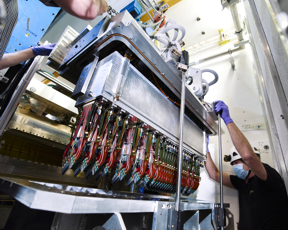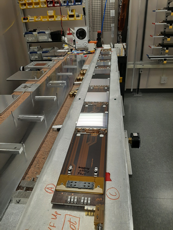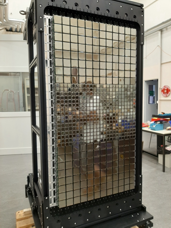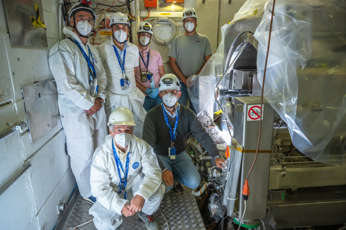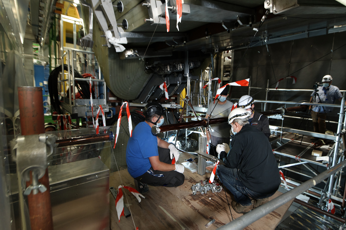Start of LHC Run 3.
Today, at 16:47, protons collided again at LHCb after a 3.5 year break known as Long Shutdown 2 (LS2). During this period the original LHCb experiment has been largely dismantled and an almost completely new detector has been constructed. At the same time improvements of the LHC collider allowed it to reach the record proton-proton collision energy of 13.6 TeV.
The majority of LHCb’s sub-detectors have been replaced or upgraded during LS2 in order to cope with much more demanding data-taking conditions as described below, using the most recent technological developments to design the new detectors. The VErtex LOcator (VELO) has been replaced by a new silicon pixel detector that will come as close as 5.1 mm to the proton beams. The tracking detectors have been replaced by a new high-granularity silicon micro-strip detector, the Upstream Tracker (UT), placed upstream of the magnet, and by the three stations of the Scintillating Fibre Tracker (SciFi), which is placed downstream of the magnet, and consists of 2.5m-long scintillating plastic fibre mats read out by silicon photo-multipliers. The RICH1 is now a brand new detector: the complete optics and mechanics have been re-designed and re-built, the mirrors have a larger curvature radius, and Hybrid Photon Detectors (HPD) have been replaced by multianode photomultipliers (pmt) in both RICH1 and RICH2 detectors. The scintillating pad detector (SPD), the preshower (PS) and the first muon chamber (M1) have been removed as they are not any more needed for the hardware-based trigger as explained below. With multiple detectors, PLUME, BCM and RMS, LHCb measures instantaneously the collision rate and reconstructs the collision region that allows the LHC to ensure a constant luminosity for the collisions in LHCb. In addition, the SMOG2 system is designed to inject noble gases to the LHCb collision area to study collisions of LHC protons with these gases in a fixed-target mode. The images were taken during construction and installation of new LHCb detector, and are seen from left to right: VELO, UT, SciFi above, and RICH2 pmt, SMOG2 and beam pipe below.
The electronics connected directly to the detector (front-end) of all sub-detectors have been modified. And last but not least, the computing power of the LHCb software event selection system (trigger) has been significantly increased, and the entire readout system together with the computer farm have been moved from underground to a complete new Data Center at the surface.
At the LHC, bunches of protons cross every 25 ns, corresponding to a frequency of 40 MHz (with about 30 MHz of events with collisions). During Run 1 and 2 the event rate was filtered down to 1 MHz with the help of fast electronics, using comparatively simple algorithms to select the most interesting events. Those events were then processed in a dedicated computer farm, located underground close to the detector; this allowed additional, more sophisticated selection criteria to be applied using software (see the 14 October 2015 news for more). For Run 3 and beyond, this has changed radically: the hardware-based trigger has been removed and the whole detector is read out at the full rate of 40 MHz. This allows the whole selection to be done in software, named Real Time Analysis by LHCb, meaning that it can be much more precise and flexible. Better yet, from Run 3 the pp collision rate at LHCb is increased by a factor of 5 (for experts: the luminosity will rise to 2×1033cm-2s-1). With the higher luminosity and a greatly improved ability to pick out the most interesting events, LHCb can look forward to much larger signal yields.
During proton-proton collisions the LHCb data taking system runs automatically under the control of just two experts, shift leader and data manager. The whole automatic system had to be set-up following installation of new detectors, new electronics and the new computer farm. This also included a set of computer programs monitoring that the whole process works correctly. During the months preceding the start of data taking, the LHCb control room was full of physicists, engineers and technicians preparing the LHCb detector for data taking which started today. This period of intensive work physicists name the commissioning.
The photo, taken today, shows the LHCb dream team in the LHCb control room. Progress of the LHCb original detector dismounting and installation of new subdetectors has been recorded and shared through LHCb social media channels, YouTube, Instagram and Facebook.

